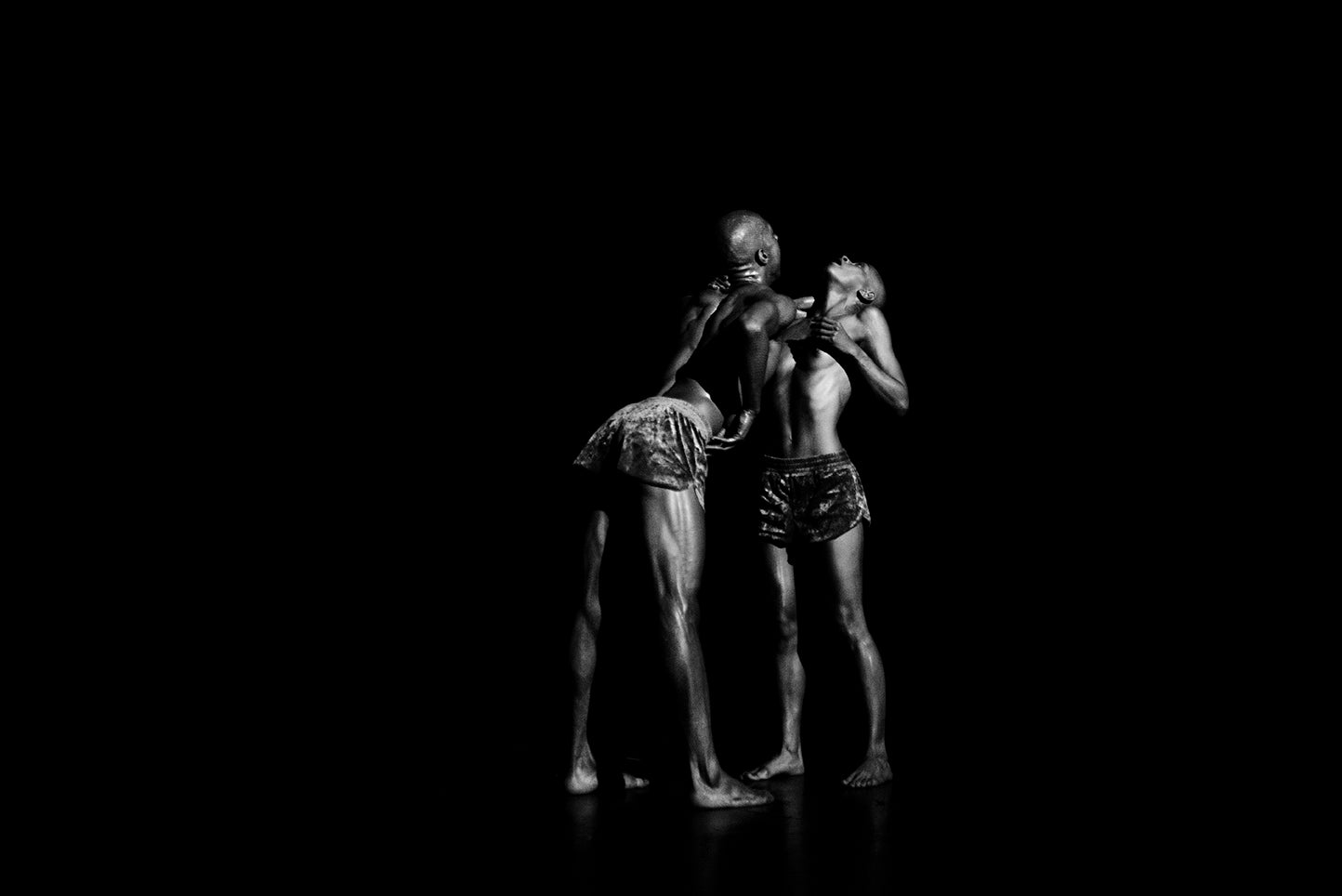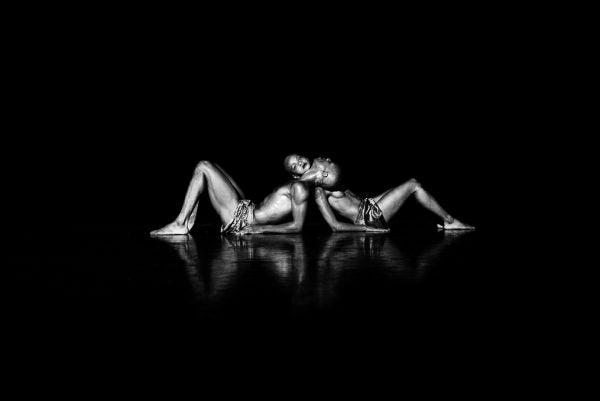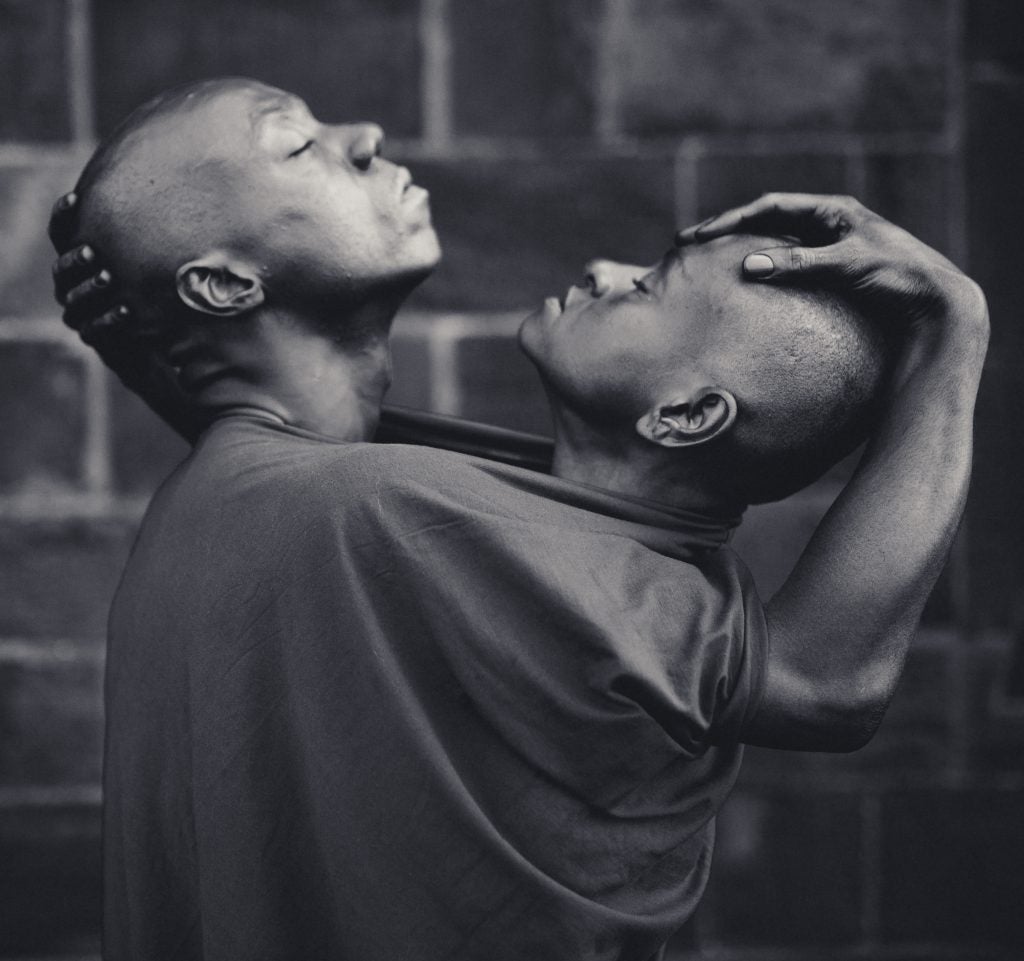In January, I trekked from D.C. to New York City in the snow for the sold-out performance of Black Velvet: Architectures and Archetypes. Five months later, I’m still thinking it. Sold out performances are becoming routine for Shamel Pitts and Mirelle Martins. The New York Times recently listed their May NYC performances of the show as one of “10 Dance Performances to See in N.Y.C. this Weekend.”
Black Velvet is the second work in a triptych that Pitts has been working on since he left Batsheva in 2016. He received his BFA in Dance from The Juilliard School and began his professional dance career with BJM_Danse Montreal and Mikhail Baryshnikov’s Hell’s Kitchen Dance. He continued his career with Batsheva Dance Company for seven years and is now a teacher of Gaga, the movement language created by Ohad Naharin. He has taught for both Batsheva Dance Company and The Young Ensemble, and stages Ohad Naharin’s repertory on many companies around the world. He is a performance artist, dancer, spoken word artist, and an adjunct teacher at Harvard University and The Juilliard School.

In September 2016, Pitts moved briefly to Brazil to teach Gaga classes around the country and to create Black Velvet with Martins, a Brazilian performance artist. Constantly traveling, Pitts and Martins made time between performances at Harvard and Gibney in New York to answer my questions. It’s my hope that those who read our exchange will one day be able to see these incredible artists perform.
When and how did you begin to dance?
Mirelle Martins (MM): I started dancing when I was 28-years-old. Before I began, I was working in communications. I was exploring art in other languages but not yet feeling that I had found my voice. In the beginning of 2013, I had a small injury in my left knee. During my recovering process, I decide to pay more attention to my body by focusing on joy rather than pain. I also decided to start to dance. I was searching for courses appropriate for a 28-year-old person who doesn’t have a dance background, and found Gaga.
I fell in love with the movement language created by Ohad Naharin and his work with Batsheva since the first time I watched YouTube videos of the movement language. I decided to take a course as soon as possible, and I came to New York to do the Gaga Summer Intensive. There I found the language I was looking for, and I also found Shamel, who was one of the teachers of the intensive.
Shamel Pitts (SP): I was always dancing. My mother would throw a lot of parties when I was a kid. I would stay up very late dancing with all of the adults. At some point during the night, I would start to organize the adults into different dance sequences and configurations. These were my beginning experiences with researching my passion to dance and choreograph.
How and when did you know dance would always be a part of your life?
MM: For me, having dance as a career is a consequence of my life purpose. What makes me more interested in dance every day is how opposite values can work and live together: strength and delicacy, pleasure and pain, material and immaterial experiences. And how the body can tell more stories than words. It’s a pleasure to perform and have the opportunity to exercise and express these and other ideas that, otherwise, would be stuck in my head.
SP: I choose dance as I choose to live. I knew that a vital part of my life’s purpose was to dance. It is my lifeline, actually. Dancing allows me to share things unseen, unspoken. Dance has been for me a bridge to communicate in ways that words have fallen short.

When did you begin your collaboration?
MM: We began working together after getting to know each other at the Gaga Summer Intensive in 2013. Shamel and I talked about bringing Gaga classes to Brazil, a project that we started in 2015. Since then we have also worked as partners in the creation of Black Velvet in 2016.
I saw you perform Black Velvet at the 14th Street Y in NYC. The piece included fascinating lighting design, music, and spoken word elements. How did you decide to use all of these artistic elements?
SP: Coming into the creation of Black Velvet, I knew/dreamt of some things about the environment in advance. For example, I knew that there would be a ladder, a dress, spoken word, and lighting executed by projection. These elements each have such symbolism.
The fun and tedious work I have to do as a choreographer has a lot to do with the arrangement of these elements in order to create harmony or dissonance such as we see with all of the elements found in nature. Mathematics is the language of nature and I love playing with numbers! All of the work is incredibly calculated, which then lends to the experience of magic and beauty.
Regarding the words: from where were these sourced? Do either of you write?
MM: I have always liked to write. Before I began dancing, I wrote poetry, a lot of which is published online. Our shared interest in poetry was something that connected Shamel and me when we first met. When we started to create Black Velvet, we brought our own writing into the studio and shared it with each other. We found similarities in our work, which is why we decided to include passages from our texts in the soundtrack. I believe it’s important to mix languages in order to share a message and create an experience. I view performance work not only the end product, but how we combine many elements to create a live experience. So the texts are one more layer of this experience.
SP: I have been writing for many years. Black Box, my first live performance art work, started as a platform for the text that I conceived of in my private book known as Little Black Book Of RED. The text from this book inspired the atmosphere and the offering inside of the world of the performance. I am now very interested in sharing this book as an art book! I hope to have the resources and partnerships to do so soon.

Photo from performance of Black Velvet by Rebecca Stella.
There are photographs of you together on Governor’s Island which were shown in a gallery right outside of the black box theater at the Y. Who took these? Do they generally travel with you when you present your work?
MM: These photographs came out of a great collaboration with the Israeli photographer Alex Apt. Alex had previously worked with Shamel. He is a great artist and brought his unique vision to Black Velvet via his photography. We’re hoping to work with him again in the future. All of the images are currently for sale on our website.
Black Velvet is the second work in a triptych: Black Box, Black Velvet, and the up and coming Black Hole. Can you give some background about the pieces?
SP: Each of the works has a huge listening and research towards what is inside of us, between us, and around us. I am constantly searching for personal truths and testaments and how they meet as well as re-imagined ideals and universal sentiments. Black Hole will be the most colorful work inside of this black series.
Do you consider your work to be political?
MM: We can say everything we do in public is political. However, we don’t see Black Box, Black Velvet, or Black Hole as solely political work. Our work is not to react, but to act.

Do audiences’ reactions differ around the globe? What’s it like performing your work in the US?
MM: Not really. We are grateful to see that in all the countries we travel, people always comment about the human aspects of the work. As Shamel says, we have more similarities than differences, and we aim to stand for the similarities.
You recently did a Black Velvet workshop at Gibney in NYC. Do you have any upcoming workshops, classes, or community outreach opportunities?
SP: Mirelle and I will be teaching Black Velvet Movement Workshops in Europe and Singapore this summer. Please check my website for updates on schedule and location.
Who inspires you?
MM: Shamel Pitts.
SP: Mirelle Martins! LOL. I am also very inspired by my friends. They are my heroes. Janelle Monae, who is my cousin actually, has a line in one of her songs that says, “We don’t need another ruler, all of my friends are kings!” I vibe with that! She is a hero and my aunts, Joycelyn Taylor and Zanthea Taylor, are my superwomen.
What’s next?
MM: Mainly the creation of Black Hole, the third and colorful chapter of the Black Trilogy. We hope to premiere the new piece in the end of 2018. Black Velvet is still on tour and we will continue to travel, sharing this work internationally.
SP: We are slow cooking Black Hole for the rest of the year. It is a very large production with artist from Brazil, South Africa, USA, and Israel. We are working intensely to raise the funds to support such a necessary endeavor and we invite all who can, to walk with us on the ride by supporting the creation.

Lead image by Alex Apt. Find out more about Pitts, Martins, and the Black Trilogy at shamelpitts.com.






